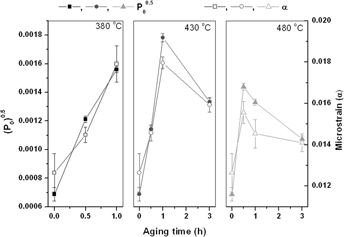Crossref Citations
This article has been cited by the following publications. This list is generated based on data provided by
Crossref.
Manojkumar, R.
Mahadevan, S.
Mukhopadhyay, C. K.
and
Singh, M. N.
2019.
Study on the Influence of Prior Cold Work on Precipitation Behavior of 304HCu Stainless Steel During Isothermal Aging.
Metallurgical and Materials Transactions A,
Vol. 50,
Issue. 11,
p.
5476.
Zhou, Tian
Xiong, Yi
Zha, Xiaoqin
Yue, Yun
Lu, Yan
He, Tian-tian
Ren, Feng-zhang
Rani, Ekta
Singh, Harishchandra
Kömi, Jukka
Huttula, Marko
and
Cao, Wei
2020.
Hot-deformation-induced structural and mechanical properties of Ce-modified SAF 2507 super duplex stainless steel.
Journal of Materials Research and Technology,
Vol. 9,
Issue. 4,
p.
8379.
Guo, Dawei
Kwok, Chi Tat
Tam, Lap Mou
Zhang, Dawei
and
Li, Xiaogang
2020.
Hardness, microstructure and texture of friction surfaced 17-4PH precipitation hardening stainless steel coatings with and without subsequent aging.
Surface and Coatings Technology,
Vol. 402,
Issue. ,
p.
126302.
Lenda, O. Ben
Tara, A.
Lazar, F.
Jbara, O.
Hadjadj, A.
and
Saad, E.
2020.
Structural and Mechanical Characteristics of AISI 420 Stainless Steel After Annealing.
Strength of Materials,
Vol. 52,
Issue. 1,
p.
71.
Sathyanath, Athul
and
Meena, Anil
2020.
Microstructural evolution and strain hardening behavior of heat-treated 17-4 PH stainless steel.
Materials Today Communications,
Vol. 25,
Issue. ,
p.
101416.
Nezhadfar, P.D.
Anderson-Wedge, Kathryn
Daniewicz, S.R.
Phan, Nam
Shao, Shuai
and
Shamsaei, Nima
2020.
Improved high cycle fatigue performance of additively manufactured 17-4 PH stainless steel via in-process refining micro-/defect-structure.
Additive Manufacturing,
Vol. 36,
Issue. ,
p.
101604.
Avula, Indu
Arohi, Adya Charan
Kumar, Cheruvu Siva
and
Sen, Indrani
2021.
Microstructure, Corrosion and Mechanical Behavior of 15-5 PH Stainless Steel Processed by Direct Metal Laser Sintering.
Journal of Materials Engineering and Performance,
Vol. 30,
Issue. 9,
p.
6924.
Guo, D.
Chen, J.
Chen, X.
Shi, Q.
Cristino, V.A.M.
Kwok, C.T.
Tam, L.M.
Qian, H.
Zhang, D.
and
Li, X.
2021.
Pitting corrosion behavior of friction-surfaced 17-4PH stainless steel coatings with and without subsequent heat treatment.
Corrosion Science,
Vol. 193,
Issue. ,
p.
109887.
Sathyanath, Athul
and
Meena, Anil
2022.
Dislocation-Precipitate Interaction-Based Kocks–Mecking Analysis of Heat-Treated 17-4 PH Stainless Steel.
JOM,
Vol. 74,
Issue. 7,
p.
2817.
Zheng, Ying
Sun, Huili
Yan, Luchun
Pang, Xiaolu
and
Gao, Kewei
2023.
Effect of aging time on crack initiation mechanism of precipitation hardening stainless steel in very high cycle fatigue regime.
International Journal of Fatigue,
Vol. 170,
Issue. ,
p.
107522.
Yu, Chun
Wang, Haodong
Yu, Zhiyuan
Huang, Yifeng
Xi, Min
Chen, Junmei
Xu, Jijin
and
Lu, Hao
2023.
Improving mechanical properties and isotropy of laser DED 17-4 PH stainless steel by combining ultrasonic vibration.
Scripta Materialia,
Vol. 236,
Issue. ,
p.
115673.
Saxena, Rishabh
Narayanan, R. Ganesh
and
Robi, P. S.
2024.
Effect of Heat Treatment on the Mechanical Property Enhancement of 17-4 PH Stainless Steel for Sheet Forming Applications.
Journal of Materials Engineering and Performance,
